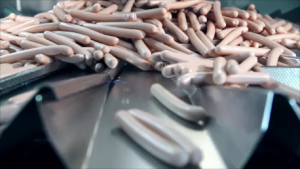Less Hard Work on the Sausage Packing Line
With an automated solution from Cabinplant, the future of sausage packing is flexible, gentle and precise. Tales of manufacturers that pay to transport workers to their factory are well known in the food industry. Faced with a shortage of labour and rising labour costs, opportunities for automated packaging are increasingly attractive to many.
“We know that the standard of living is going up in many parts of the world. This makes it less attractive to work on the shop floor in a food factory,” says Morten Dissing, area sales manager at Cabinplant, a leading supplier of food processing and packing solutions. “It was this that inspired us to develop our automated sausage depositor.”
Sausage packing has traditionally been carried out on highly labour-intensive machines, where operators ensure sausages are arranged in orderly layers ready for packaging. The Cabinplant sausage depositor takes over this role, quickly adapting to a wide variety of sausage and pack sizes.
Future-secure Flexibility
In the sausage business, such flexibility is a key word. This is why each Cabinplant solution is sold with a series of depositor tools to cater for present and future packaging needs.
 “Our design means it takes less than 15 minutes to change over to a new sausage type or pack size, so there is very little production downtime. One operator can easily manage the task,” Dissing explains.
“Our design means it takes less than 15 minutes to change over to a new sausage type or pack size, so there is very little production downtime. One operator can easily manage the task,” Dissing explains.
Reducing Damage and Give-away
For manufacturers, gentle handling is essential to minimise product damage on the line and rework. Another key issue is ‘give-away’ – the extra grams of product that manufacturers allow in each pack to ensure the actual weight is never below the weight stated on the pack label.
The Cabinplant sausage depositor overcomes these challenges through two exclusive features.
One is the vibrating action used to transport and align sausages on the machine. While conventional mechanical conveyors cause up to 5% product damage, this is virtually eliminated by the vibrating mechanism.
Optimising Pack Weight
The other is the multi-head weighing machine that not only ensures the right number of sausages in each packaging, but also accounts for small variations in the weight of each sausage. In this way, sausages are selected from the weighing channels and combined in portions of optimum weight.
 “Through the use of an accurate weighing system, the average sausage weight can be reduced without risk of failing to meet the stated pack weight,” says Dissing. He gives a real-life example: “If the average weight is reduced by, say, 1.5g per sausage, then give-away for a pack of six is reduced by 9g. Over a year, the total product saving is close to 30 tonnes.”
“Through the use of an accurate weighing system, the average sausage weight can be reduced without risk of failing to meet the stated pack weight,” says Dissing. He gives a real-life example: “If the average weight is reduced by, say, 1.5g per sausage, then give-away for a pack of six is reduced by 9g. Over a year, the total product saving is close to 30 tonnes.”
In other words, 30 tonnes are no longer given away for free.
Capacity – A Positive Surprise
Cabinplant project manager Allan Hansen Nissen has focused on developing an adaptable, layout-friendly solution that can satisfy most customers’ needs for a tailor-made solution. In his experience, customers are positively surprised by the high efficiency and throughput compared to the number of operators on the line.
“Most sausage manufacturers talk about capacity in terms of kilos per hour. Our system can achieve a similar capacity to traditional labour-intensive lines – in some applications, even higher. And they need only a few operators to run at this high capacity,” he comments.
With less downtime, give-away and waste on the line, manufacturers can look forward to a flexible and future-proof sausage-packing operation with a fast return on investment. That’s an automation opportunity worth exploring.


































